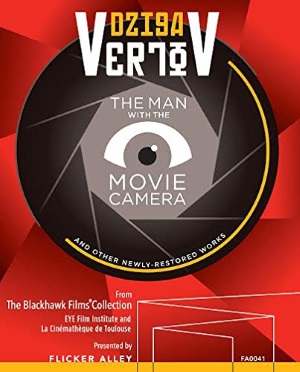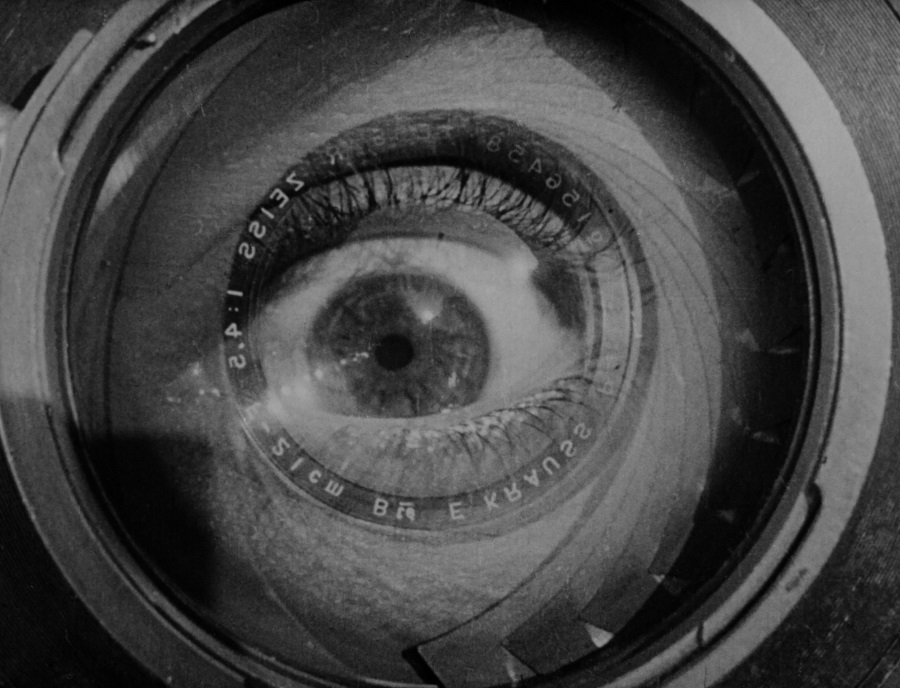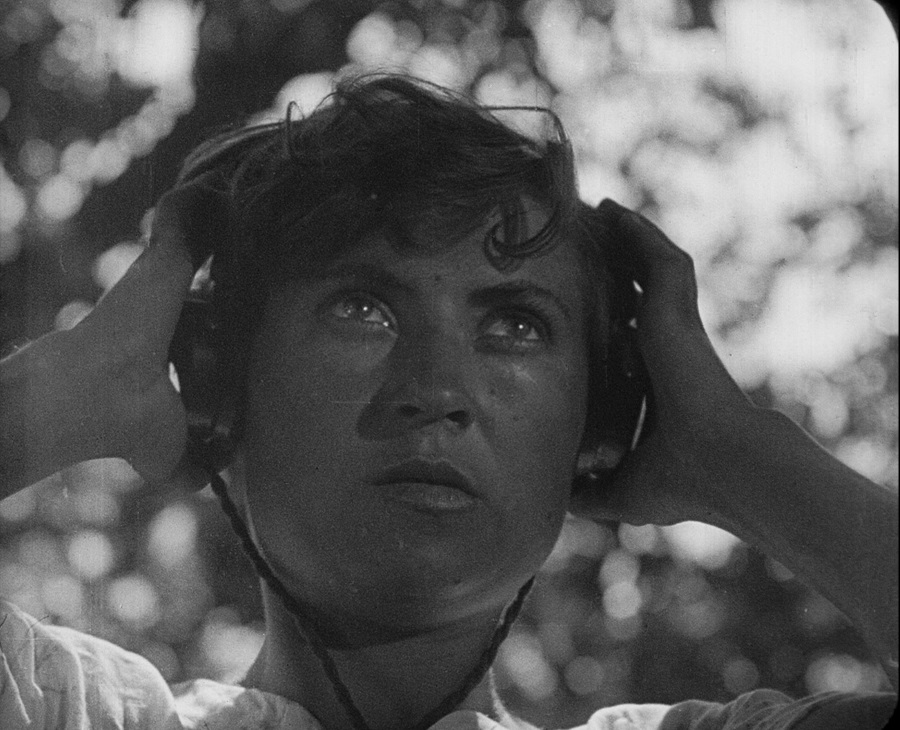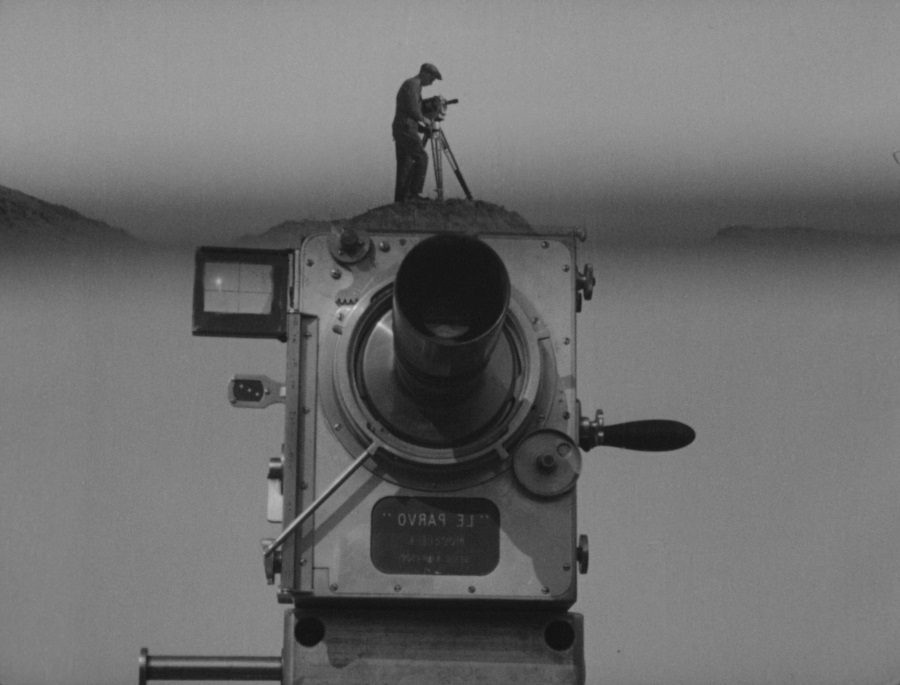 Dziga Vertov: The Man with the Movie Camera and Other Newly-Restored Works (Flicker Alley, Blu-ray) presents four features (and one newsreel short) by the great Soviet filmmaker, all making their American Blu-ray debut. They have been newly scanned from the best sources available and digitally remastered by Lobster Films in France. The collection is a collaboration between Lobster, Film Preservations Associates (and the Blackhawk Films Collection), EYE Film Institute, Cinémathèque de Toulouse, and the Centre National de la Cinématographie and is presented in the U.S. by Flicker Alley.
Dziga Vertov: The Man with the Movie Camera and Other Newly-Restored Works (Flicker Alley, Blu-ray) presents four features (and one newsreel short) by the great Soviet filmmaker, all making their American Blu-ray debut. They have been newly scanned from the best sources available and digitally remastered by Lobster Films in France. The collection is a collaboration between Lobster, Film Preservations Associates (and the Blackhawk Films Collection), EYE Film Institute, Cinémathèque de Toulouse, and the Centre National de la Cinématographie and is presented in the U.S. by Flicker Alley.
The Soviet Union’s revolutionary documentarian and film theorist, Dziga Vertov was the head of production and editing of the Kino-Pravda newsreel unit between 1922 and 1925. He put his years of experimentation in weekly newsreels to work in the 1924 feature film with Kino Eye / The Life Unexpected (1924), a continuation of his work on the Kino-Pravda series. The mixture of slice of life observations (often captured with a hidden camera) with documentary studies and playful cinematic tricks was his first attempt to create a new kind of filmmaking celebrating life in the Soviet Union under communism. The episodic film is structured something like a variety show, with the recurring thread of “Young Pioneers,” a youth brigade of Soviet boys and girls dedicated to helping the poor and needy, running through the film as a kind of narrative glue. Nestled between these uplifting sequences are glimpses into taverns and bars, a state home for the mentally ill, and the black market, fanciful documentary investigations into the origins of bread and meat (from the slaughterhouse to the farm), and a scene of kids at play in the water that turns into a gorgeous diving montage that presages Leni Riefenstahl’s Olympia by over ten years.
The source for this master was an original 35mm print from the Blackhawk Films Collection
The Man with the Movie Camera (1929) is Vertov’s most famous film, a landmark of Soviet silent cinema and international avant-garde and non-fiction filmmaking—a pretty impressive double play to be celebrated for both capturing and deconstructing reality. Part documentary, part film essay, part cinematic gymnastics, Dziga Vertov’s dazzling masterpiece is a spellbinding piece of cinematic poetry and one of the great non-narrative works of all time. It’s ostensibly a kind of symphony of a city, a day in the life of a big city for the Ukraine, but Vertov shot in multiple cities for his idealized portrait. Using all the ideas and experiments he had explored for years in his newsreel pieces, he created a film essay that celebrated the great Soviet experiment while challenging the very foundations of representation, editing, and narrative with images that dance on the screen. The man with the movie camera and the woman at the editing table are integral parts of a film that is in part about its own making and the possibilities inherent in the cinema. The Alloy Orchestra, guided by suggestions left by director Dziga Vertov, created a score built on their trademark mix of dramatic melody and expressive percussion—which is exactly what Vertov wanted. It’s an exciting, driving score that I now consider the definitive accompaniment. This edition features that score.
It’s also the best looking film on this disc. Previous editions were mastered from compromised prints, missing footage from damage or outright recutting and often duped down many generations for the source. This editions is mastered from a preserved, near-complete 35mm nitrate print struck from the camera negative and preserved in the archives of EYE Film Institute in Amsterdam. It preserves the full silent film image area (rather than a sound-era copy with reduced image area) and, though it has wear and some damage due to screenings over the decades, the image is quite strong. Missing footage was replaced from alternate sources and the high-definition digital copy was further cleaned by Lobster films. A detailed history of the film print and the restoration process is included in an accompanying booklet. In short, this edition features a fuller image and footage missing from previous editions.

‘The Man with the Movie Camera’
Vertov made his sound film debut with Enthusiasm: The Symphony of the Donbass (1931), his celebration of the Five Year Plan, which is an unqualified success under his direction. It opens on a woman listening to the news of the Soviet experiment over a radio set the scenes play out as if illustrating what she’s learning over the air. No surprise that Vertov treats sound much the same way he treats images: as pieces to be manipulated, cut and mixes to set a scene or make a point. There’s very little synchronized sound and no dialogue (though there’s a speech or two). Rather, he turns to the sounds of machinery and the cheers of crowds, with punctuations of sound effects providing a heightened percussion. Early on we see a conductor leading an orchestra and you would be forgiven for assuming that the symphony is a musical composition. For Vertov, the symphony is the image and sound, the dramatization of workers increasing production in the mines and foundries and on the farms, the building of ideas and themes to socialism triumphant. “The five year plan has been executed in four years!” and the masses rejoice.
There is damage and wear to the source, and a 35mm original print from the Cinémathèque de Toulouse, but there is a great image beneath it and there is great detail in this HD Blu-ray presentation. There is also a warble to the soundtrack, which was restored in 204, in scenes toward the end.

‘Enthusiasm: The Symphony of the Donbass’
Three Songs About Lenin (1934), Vertov’s tribute to the leader who died in 1924, completes the set. It’s a symphony in three movements celebrating the triumph of socialism and the unity of industry and art. Which is not exactly what Stalin had in mind to teach the masses. Like Eisenstein, Vertov faced pressure to make more naturalistic narratives and clearer propaganda. The original cut of no longer survives—the film was reedited in 1938 under order Stalin’s regime, and again in the 1970s, this time to remove images of Stalin—and the film on this disc was mastered from a 35mm edited print preserved at the Cinémathèque de Toulouse.
All of the films run under 80 minutes, three of them at around an hour apiece. The disc, however, includes one additional film: Kino-Pravda (1925), aka Kino-Pravda Newsreel 21: Leninist Film Truth, one of the many newsreels created by Vertov that mixed documentary, cinema-verité, and agitprop. Also from the Cinémathèque de Toulouse.
All five films are collected on a single Blu-ray disc and the release features an informative booklet with notes on the films and the print sources.
Normally I don’t report on new announcements but if the above release interests you, you’ll likely be interested to know that the newly rediscovered 1916 Sherlock Holmes starring William Gillette (who made a career playing Sherlock Holmes onstage and was the definitive stage Holmes as far as the public was concerned) will be released on Blu-ray and DVD in October by Flicker Alley. There will be a wealth of bonus material, including three bonus films featuring earlier screen appearances by Sherlock Homes. More information at Flicker Alley.
Calendar of upcoming releases on Blu-ray, DVD, Digital, and VOD

